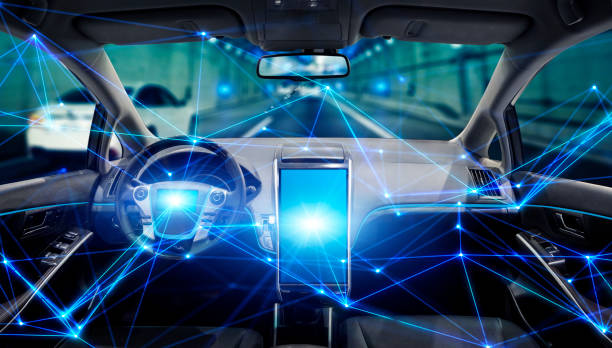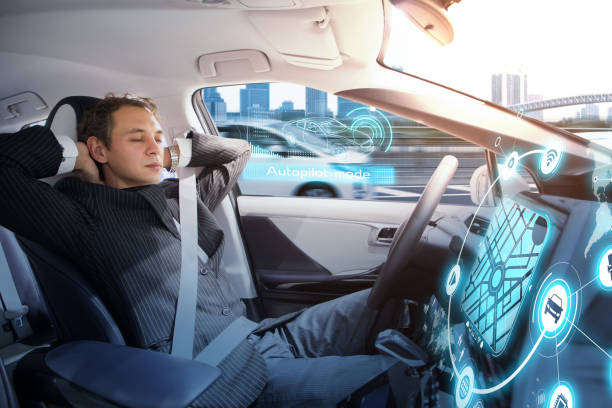Introduction
In the world of autonomous vehicles (AVs), the integration of Human-Machine Interfaces (HMIs) plays a pivotal role in ensuring safe, user-friendly, and efficient transportation experiences. As technology continues to advance, the focus on human-centered design and HMI innovations is gaining significant traction, leading to a surge in patent filings and intellectual property (IP) protection in this domain. Developing a robust patent strategy for Autonomous Vehicle Human-Centered HMI is critical for both protecting intellectual property and fostering innovation in this dynamic industry. This article aims to explore the key elements of patent strategies in the context of AV Human-Centered HMIs, highlighting the challenges, opportunities, and best practices to navigate this rapidly evolving landscape.

Understanding the Landscape of Autonomous Vehicle Human-Centered HMI
The integration of Human-Centered HMIs in autonomous vehicles is a multidimensional process that involves intricate technical, behavioral, and ergonomic considerations. It encompasses various aspects, including user interaction, safety protocols, data visualization, and user experience (UX) design. From voice recognition systems to gesture controls, touch screens, and augmented reality displays, the domain of AV HMIs is continuously expanding to create seamless and intuitive interactions between passengers and self-driving vehicles.
1. Technological Integration
Autonomous Vehicle Human-Centered HMIs incorporate a diverse array of technologies such as natural language processing, gesture recognition, facial expression analysis, touchscreens, haptic feedback, and augmented reality (AR) displays. These technologies work in tandem to facilitate effective communication and interaction between passengers and the autonomous vehicle system.
2. User Experience (UX) Design
UX design forms the cornerstone of Human-Centered HMIs, focusing on simplifying complex information, streamlining controls, and ensuring a user-friendly interface for passengers. Design elements include intuitive layouts, easily accessible controls, and informative displays that provide relevant information about the vehicle’s operations and surroundings.
3. Safety and Ergonomics
Ensuring passenger safety remains a critical concern in the design of Autonomous Vehicle Human-Centered HMIs. The integration of safety protocols, real-time monitoring systems, and intuitive alerts contributes to a secure and reliable driving experience. Moreover, ergonomic considerations play a vital role in designing interfaces that minimize distractions and promote comfortable interaction within the vehicle.
4. Adaptive Learning and Personalization
Human-Centered HMIs often incorporate adaptive learning algorithms that personalize the driving experience based on individual preferences and behaviors. These systems gather data on user interactions and driving patterns, subsequently adjusting the HMI settings to cater to the specific needs and preferences of each passenger.
5. Regulatory Compliance and Standards
The landscape of AV Human-Centered HMI is influenced by a complex web of regulatory frameworks and safety standards that govern the development and deployment of autonomous vehicles. Compliance with regulations related to data privacy, cybersecurity, and vehicle safety is paramount, shaping the design and functionality of HMIs within the autonomous vehicle ecosystem.
6. Accessibility and Inclusivity
Ensuring accessibility and inclusivity in HMI design is gaining prominence within the landscape of autonomous vehicles. Designing interfaces that cater to the needs of individuals with diverse physical abilities, sensory impairments, and varying technological literacy levels is crucial for creating an inclusive transportation environment.
7. Integration of AI and Machine Learning
AI and machine learning technologies are instrumental in enhancing the capabilities of Autonomous Vehicle Human-Centered HMIs. These technologies facilitate predictive analysis, contextual understanding, and adaptive decision-making, thereby enabling the HMI systems to anticipate user needs, optimize driving routes, and ensure proactive safety measures.
Understanding the intricate interplay of these components within the landscape of Autonomous Vehicle Human-Centered HMI is fundamental for devising robust and innovative solutions that redefine the future of autonomous transportation. By prioritizing user-centric design, technological integration, safety compliance, and adaptability, stakeholders in the autonomous vehicle industry can pave the way for a transformative and immersive driving experience that prioritizes both technological advancement and human well-being.

Challenges in Patenting Autonomous Vehicle Human-Centered HMI
Patenting Autonomous Vehicle Human-Centered Human-Machine Interfaces (HMI) presents several unique challenges due to the intricate nature of the technology and the interdisciplinary aspects involved. These challenges encompass technical, legal, and regulatory complexities, often demanding a comprehensive approach to intellectual property (IP) protection. Some of the key challenges in patenting Autonomous Vehicle Human-Centered HMI include:
1. Interdisciplinary Nature
The development of Autonomous Vehicle Human-Centered HMIs involves the convergence of various disciplines such as software engineering, human psychology, ergonomics, hardware integration, and AI. Patenting such interdisciplinary innovations requires a deep understanding of multiple technical domains, making it imperative for inventors and patent attorneys to collaborate closely to articulate the technical intricacies of the invention accurately.
2. Prior Art and Non-Obviousness
Demonstrating the novelty and non-obviousness of HMI innovations in the context of prior art can be a significant challenge. With a multitude of patents, scientific literature, and emerging technologies, establishing the unique features and inventive step of Autonomous Vehicle Human-Centered HMIs demands thorough research and a keen understanding of the specific problem-solving approaches and technical advancements that differentiate the invention from existing solutions.
3. Regulatory Compliance and Standards
The landscape of autonomous vehicles is regulated by various industry standards and governmental regulations aimed at ensuring safety, privacy, and security. Aligning patent strategies with these evolving regulatory frameworks is crucial to prevent legal hurdles during the patent application process and to ensure that the patented technology is compliant with the requisite industry standards.
4. Complexity of Software Patents
The patentability of software in the context of Autonomous Vehicle Human-Centered HMIs can be particularly challenging, given the evolving jurisprudence around software patents. Establishing the technical effect and industrial applicability of software-based inventions while navigating the legal nuances of patent eligibility requires a comprehensive understanding of both the technical and legal aspects of software development and patent law.
5. Global Patent Protection and Enforcement
As the autonomous vehicle industry operates on a global scale, securing and enforcing patents across different jurisdictions can be a complex and resource-intensive process. Dealing with varying patent laws, procedures, and enforcement mechanisms in different countries demands a robust global patent strategy to safeguard intellectual property rights and prevent unauthorized use and exploitation of HMI technologies internationally.
6. Rapid Technological Evolution and Short Product Cycles
The rapid pace of technological advancements and the short product cycles in the autonomous vehicle industry pose a challenge to patenting Autonomous Vehicle Human-Centered HMIs. Innovations can quickly become obsolete, and the window of exclusivity provided by a patent may not align with the product development timelines, necessitating agile patent strategies that account for the fast-paced evolution of technology in the sector.
Overcoming these challenges requires a proactive and comprehensive approach to patenting, including thorough prior art searches, collaboration with interdisciplinary teams, proactive regulatory compliance measures, clear articulation of technical advantages, and a strategic global patent filing strategy. By addressing these challenges effectively, stakeholders in the autonomous vehicle industry can ensure robust protection of their innovative Autonomous Vehicle Human-Centered HMI technologies and foster continued advancements in this transformative field.
Developing an Effective Patent Strategy for AV Human-Centered HMI
To overcome the challenges associated with patenting AV Human-Centered HMIs, companies and innovators must adopt a comprehensive patent strategy that encompasses the following key elements:
1. Prior Art Analysis
Conducting an exhaustive prior art search to identify existing patents, publications, and technologies related to AV Human-Centered HMIs is the first step in developing a robust patent strategy. This analysis helps in understanding the existing technological landscape, identifying white spaces for innovation, and formulating unique selling propositions (USPs) for the proposed HMI solutions.
2. Technology Scouting and Collaboration
Engaging in technology scouting initiatives and fostering collaborations with research institutions, universities, and industry peers can provide valuable insights into emerging technologies and industry trends. Collaborative efforts enable knowledge sharing, accelerate R&D processes, and enhance the novelty and inventiveness of HMI solutions.
3. Comprehensive IP Portfolio Management
Establishing a comprehensive IP portfolio management system is imperative for safeguarding intellectual property rights and maximizing the commercial value of AV HMI innovations. This includes regularly monitoring and updating patent portfolios, conducting periodic IP audits, and strategically aligning IP assets with business goals and market trends.
4. Legal Expertise and Regulatory Compliance
Seeking guidance from legal experts specializing in patent law and autonomous vehicle regulations is essential for ensuring compliance with intellectual property laws and industry-specific standards. Legal counsel can assist in drafting robust patent applications, navigating patent prosecution procedures, and addressing potential infringement issues proactively.
5. Global Patent Protection
Considering the global nature of the autonomous vehicle industry, securing international patent protection is crucial for preventing unauthorized use and exploitation of HMI technologies across different jurisdictions. Implementing a comprehensive global patent filing strategy can help in securing broader protection and market exclusivity, thereby enhancing the competitive advantage of AV HMI innovations.
6. Continuous Innovation and Adaptation
Promoting a culture of continuous innovation and adaptability within the organization fosters the development of cutting-edge AV HMI solutions. Encouraging interdisciplinary collaboration, fostering a conducive work environment for creative ideation, and incorporating user feedback into the product development lifecycle are essential for staying ahead of market trends and evolving consumer preferences.

Future Prospects and Emerging Trends in AV Human-Centered HMI Patent Strategies
Looking ahead, the future of Autonomous Vehicle (AV) Human-Centered Human-Machine Interface (HMI) patent strategies is poised to witness a series of transformative trends and advancements. As the autonomous vehicle industry continues to evolve, patent strategies for AV Human-Centered HMI are expected to adapt to emerging technologies and shifting consumer demands. Some of the key future prospects and emerging trends in AV Human-Centered HMI patent strategies include:
1. Emphasis on Data Privacy and Security
With the increasing integration of advanced data analytics and AI-driven technologies in AV HMIs, there will be a growing emphasis on data privacy and security in patent strategies. Innovators will need to focus on implementing robust encryption protocols, data anonymization techniques, and secure communication channels to safeguard user data and ensure compliance with evolving data protection regulations.
2. Integration of Biometric Sensing Technologies
The integration of biometric sensing technologies, such as facial recognition, voice biometrics, and physiological monitoring, will redefine the landscape of AV Human-Centered HMIs. Patent strategies will need to explore innovative approaches to leverage biometric data for personalized user experiences, enhanced safety measures, and seamless authentication processes within autonomous vehicles.
3. Augmented Reality and Virtual Reality Integration
The incorporation of augmented reality (AR) and virtual reality (VR) elements in AV HMIs will revolutionize how passengers perceive and interact with their surroundings during autonomous rides. Future patent strategies will focus on leveraging AR/VR technologies to provide real-time navigation assistance, immersive entertainment, and contextual information displays within autonomous vehicles, enhancing the overall passenger experience.
4. Advancements in Natural Language Processing and Conversational AI
AV Human-Centered HMIs will see significant advancements in natural language processing and conversational AI, enabling more intuitive and seamless interactions between passengers and the vehicle. Patent strategies will need to leverage these advancements to develop HMI solutions that can accurately interpret and respond to natural language commands, facilitating a more user-friendly and personalized experience for passengers.
5. Integration of Emotion Recognition and Sentiment Analysis
Future AV HMIs may integrate emotion recognition and sentiment analysis technologies to better understand and respond to passengers’ emotional states and needs. Patent strategies will need to focus on protecting innovations that enable vehicles to adapt their behavior and responses based on passengers’ emotions, thereby enhancing the overall comfort and well-being of passengers during their autonomous journeys.
6. Sustainable and Eco-Friendly HMI Solutions
With the growing emphasis on sustainability and eco-conscious technologies, future AV Human-Centered HMIs may incorporate sustainable materials, energy-efficient displays, and eco-friendly design elements. Patent strategies will need to prioritize innovations that promote environmental sustainability and contribute to reducing the carbon footprint of autonomous vehicles, aligning with the broader industry trend toward sustainable transportation solutions.
7. Enhanced Accessibility Features and Inclusive Design
Future AV Human-Centered HMIs will place a greater emphasis on accessibility features and inclusive design, catering to the needs of passengers with diverse abilities and requirements. Patent strategies will need to focus on developing HMI solutions that prioritize accessibility, inclusivity, and universal design principles, ensuring that autonomous vehicles are accessible and usable for all passengers, regardless of their physical or cognitive capabilities.
By embracing these future prospects and emerging trends, stakeholders in the autonomous vehicle industry can develop robust patent strategies that not only protect their intellectual property but also drive innovation and differentiation in the rapidly evolving landscape of AV Human-Centered HMIs. Proactive patenting in these areas will be critical in establishing a competitive edge, fostering technological advancements, and shaping the future of autonomous transportation.
Conclusion
In the rapidly evolving landscape of autonomous vehicles, Human-Centered HMIs play a pivotal role in shaping the future of transportation experiences. Developing a robust patent strategy tailored to the specific challenges and opportunities in AV HMI innovation is crucial for fostering technological advancements, protecting intellectual property rights, and gaining a competitive edge in the global market. By embracing a proactive approach to patenting, collaborating with industry experts, and staying abreast of emerging trends, companies and innovators can unlock new avenues for growth and differentiation in the realm of Autonomous Vehicle Human-Centered HMIs.


